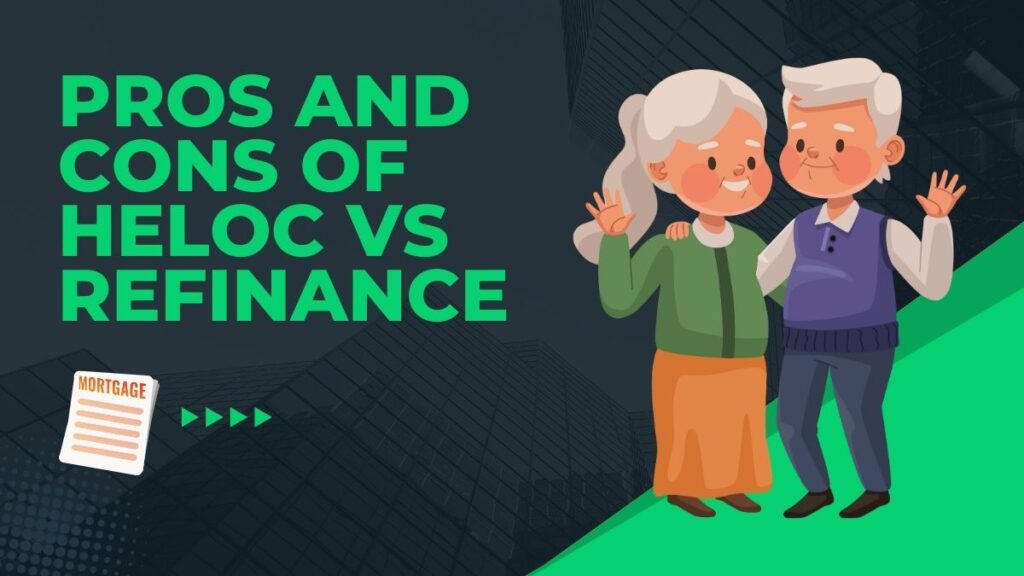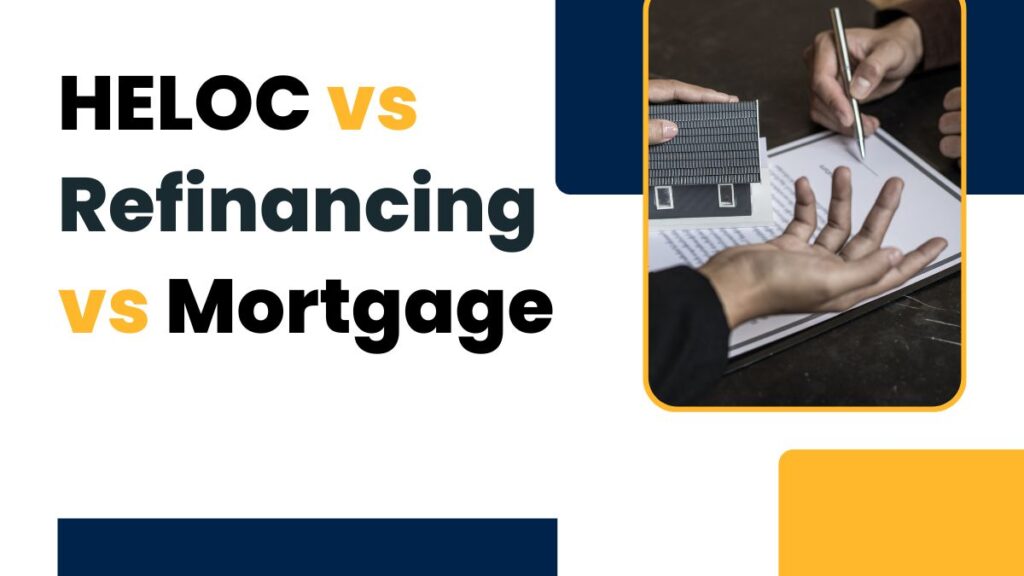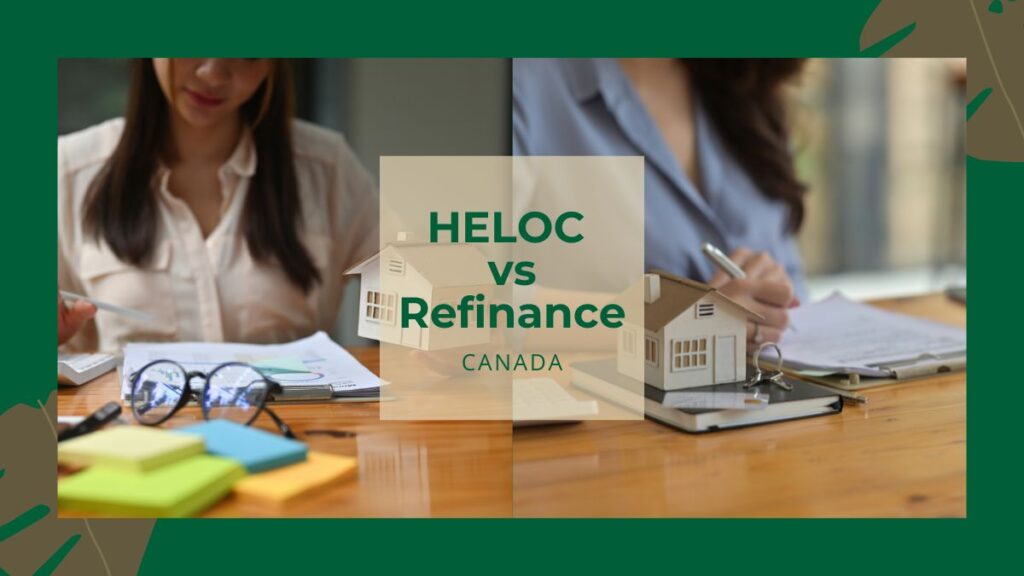Learn the pros and cons of HELOC vs refinance to find the best option for your needs. Get simple, expert advice on mortgage solutions today.
Think of your home as a treasure chest full of possibilities—your equity. Over time, you’ve built this valuable resource, and now you’re at a point where you’re asking, Should I use a HELOC (Home Equity Line of Credit), or should I refinance my mortgage? Both are great tools, but the right choice depends on your needs.
In this guide, we’ll break it all down for Canadian homeowners:
Did you know that Canadian homeowners have, on average, over $185,000 in home equity? That’s a lot of potential you can tap into for big plans or unexpected needs. Whether you’re upgrading your kitchen, tackling debt, or building a rainy-day fund, understanding your options is the first step.
By the end, you’ll know which choice works best for you. Ready to explore the possibilities? Let’s get started!
What is a HELOC?
A Home Equity Line of Credit (HELOC) allows you to borrow money using the equity in your home. Think of it like a flexible loan, where you can borrow as much or as little as you need, whenever you need it, with your home as collateral. It’s an option many homeowners use for large expenses like renovations, paying off high-interest debt, or covering unexpected costs.
Key Features
Variable Interest Rates
The interest rate for a HELOC can change over time, meaning your payments could go up or down depending on the market. This gives you flexibility, but also requires careful planning.
Draw Period
During the first 10 years, you can borrow from your HELOC whenever you need, and typically, you’ll only pay interest on what you borrow. This gives you access to cash while keeping payments lower.
Repayment Period
After the draw period ends, you’ll start paying back the money you borrowed, plus interest. This period usually lasts 10 to 20 years, and payments will be higher as you pay both principal and interest.
How It Works?
Imagine you have $100,000 in home equity and a $50,000 HELOC. If you borrow $20,000 for a renovation, you’ll only pay interest on that amount during the draw period. If you need more later, you can borrow again, up to your credit limit.
Why Choose a HELOC?
It’s flexible and works well for ongoing expenses like home improvements or covering emergencies.
You only pay interest on what you borrow, not your entire credit limit.
However, because your home is on the line, it’s important to borrow responsibly and make a plan for repayment.
What is Refinancing?
Refinancing means replacing your current mortgage with a new one. This can help you get a better interest rate, change your loan terms, or even access cash from your home’s equity. It’s a good option if you want to save money or manage big expenses.
Types of Refinancing
Cash-Out Refinance
This lets you borrow more than you owe and take the extra money. You can use it for home improvements, debt repayment, or other needs.
Rate-and-Term Refinance
This option helps you change the terms of your mortgage, like getting a lower interest rate or a shorter loan term. It can lower your monthly payments or save you money in the long run.
How It Works?
For example, if your home is worth $300,000 and you owe $200,000, you could refinance for $250,000 and get $50,000 in cash. Or, with a rate-and-term refinance, you could lower your interest rate or switch to a shorter loan to pay off your mortgage faster.
Why Consider Refinancing?
Refinancing can help reduce your monthly payments or give you access to cash.
It can also help you pay off your mortgage sooner with a shorter loan term.
Just keep in mind, refinancing can involve some fees, so weigh the savings against the costs.
In the next section, we’ll compare refinancing with a HELOC to help you choose what’s best for your situation. Stay with us!
Pros And Cons of HELOC vs Refinance
Choosing Between a HELOC and Refinance? Explore the pros and cons of each and discover the best mortgage solutions to fit your financial goals!
HELOC Pros
Flexibility
You can borrow as much or as little as you need, whenever you need it, up to your credit limit. This makes it ideal for ongoing expenses like home improvements or emergency costs.
Lower Initial Payments
During the draw period, you only pay interest on the amount you borrow. This keeps your payments lower at first, giving you some breathing room.
Ongoing Access to Funds
If you don’t use the full credit limit upfront, you can continue borrowing as needed. This is perfect for projects or expenses that come up over time.
Pay Interest Only on What You Use
Unlike a lump sum loan, you only pay interest on the amount you’ve borrowed, not the entire credit limit. This can save you money.
Ideal for Short-Term Needs
If you need quick access to cash but don’t want to commit to a large loan, a HELOC can be a smart choice.
HELOC Cons
Variable Interest Rates
The interest rate is usually tied to the market, so it can rise or fall. If rates go up, your payments could increase, making budgeting harder.
Risk of Debt
Since your home is the collateral, borrowing too much and not paying it back could put your home at risk. It’s important to borrow wisely.
Payment Shock
After the draw period (typically 10 years), you’ll need to start paying both principal and interest. This can lead to a big increase in your payments, so it’s important to plan ahead.
Annual Fees
Some HELOCs charge annual fees or other costs that can add up over time, making them more expensive than you might expect.
Temptation to Over-Borrow
With easy access to a large credit limit, it can be tempting to borrow more than you actually need. This could lead to more debt and higher interest payments.
Refinancing Pros
Lower Fixed Payments
Refinancing can help you secure a lower interest rate, or change your loan term, which can reduce your monthly payments. This can make your mortgage more affordable.
Access to Cash
A cash-out refinance lets you tap into your home’s equity and get a lump sum of money. This cash can be used for things like home repairs, paying off debt, or big expenses.
Predictable Payments
If you choose a fixed-rate mortgage, your payments will stay the same for the entire loan term. This makes it easier to plan and budget since you’ll know exactly what to expect.
Pay Off Debt Faster
If you refinance to a shorter loan term, you could pay off your mortgage more quickly. While your payments might go up, you’ll pay less in interest over time.
Consolidate Debt
With a cash-out refinance, you can use the money to pay off higher-interest debts, such as credit cards or personal loans. This can simplify your finances and save you money in interest.
Refinancing Cons
Closing Costs
Refinancing typically comes with fees, like appraisal costs and title insurance. These costs can add up and may offset the savings you get from a lower interest rate.
Longer Loan Terms
If you refinance to a longer loan term, your monthly payments may be lower, but you could end up paying more in interest over the life of the loan.
Less Flexibility
Once you refinance, you’re locked into the new loan terms. You can’t borrow more money unless you refinance again, which could come with additional fees.
Resetting Your Mortgage
Refinancing often resets the clock on your mortgage, meaning you’ll be paying off your loan for a longer period. This could delay when you’re free of your mortgage.
Risk of More Debt
If you take out too much money through a cash-out refinance, you might end up with more debt to pay off, possibly at a higher interest rate than your original loan.
Use Cases: Which Option Fits Your Situation?
Not Sure Which Loan Fits Your Needs? Discover real-life situations where a HELOC or second mortgage could be the perfect solution for you!
Choose a HELOC if…
You need flexibility for ongoing projects
A HELOC is great for home renovations or improvements that happen over time. You can borrow as you go, making it easy to manage your budget.
You have unpredictable expenses
Whether it’s medical bills or emergency costs, a HELOC gives you quick access to funds when you need them most.
You’re planning for education costs
A HELOC can help cover your child’s education expenses, allowing you to borrow over time as needed.
Opt for Refinancing if…
You want to lower your monthly payments
If you can secure a better interest rate, refinancing can reduce your monthly mortgage payments and free up cash for other expenses.
You need to consolidate high-interest debt
Refinancing allows you to roll your high-interest debt into your mortgage, making it easier to pay off with a lower interest rate.
You need a lump sum for a big purchase
If you’re looking to buy a vacation home or make a large purchase, a cash-out refinance gives you a lump sum to cover it.
Important Considerations
Before deciding between a HELOC and refinancing, think about these key points:
Interest Rates
HELOC: Interest rates are usually variable, meaning they can change over time. This could mean lower payments when rates are low, but higher payments if rates go up.
Refinancing: With fixed rates, your interest stays the same throughout the loan, which makes payments predictable and easier to manage.
Loan Term and Payments
HELOC: You can borrow money for a set time (usually 10 years), and pay just interest during that period. After that, your payments will go up because you’ll start paying off the loan’s principal as well.
Refinancing: You can choose how long you want to pay back the loan, like 15 or 30 years. A longer term means lower payments, but you might pay more interest in the end. A shorter term means higher payments but less interest over time.
Access to Funds
HELOC: Gives you ongoing access to money. You can borrow, repay, and borrow again as needed. This is great for projects or expenses that come up over time.
Refinancing: Gives you a lump sum of money upfront, which is useful for big expenses but doesn’t offer ongoing access to funds.
Risk
HELOC: Your home is the collateral, meaning you could lose it if you can’t pay back the loan.
Refinancing: Your home is also the collateral here, but with a clear repayment plan, you have a set schedule of payments, which can make it easier to manage.
Closing Costs
HELOC: Usually has lower setup costs, but you may have annual fees.
Refinancing: Comes with closing costs, like appraisal fees and loan origination fees, which can add up.
By keeping these points in mind, you can decide which option—HELOC or refinancing—works best for your situation.
How AJP Mortgage Can Help?
Deciding between a HELOC and refinancing can seem complicated, but AJP Mortgage is here to guide you through it. Here’s how we can help:
Expert Guidance
We take the time to understand your needs and goals. Whether you are looking for the flexibility of a HELOC or want to lower your monthly payments with refinancing, we will clearly explain your options so you can make the best choice for you.
Access to Multiple Lenders
We work with many lenders, giving you access to a range of options and competitive rates. This means we can help you find the best deal, whether you choose a HELOC or refinancing your mortgage.
Easy Process
We know that the process can feel overwhelming. Our team will walk you through every step, from understanding your options to filling out the paperwork. We make sure everything is clear and stress-free.
Fast Service
Whether you need quick access to funds or want to refinance to lower your payments, we act quickly to help you meet your goals. We make sure the process moves along smoothly and without delays.
Ongoing Support
Our support doesn’t stop after you make your decision. We are here to help with any questions or adjustments you might need in the future.
At AJP Mortgage, we make it simple for you to find the right solution. Reach out today to get started!
Case Studies
At AJP Mortgage, we’ve helped many homeowners find the right solutions to meet their needs. Here are a few examples of how we’ve made a difference:
Case Study 1: Sarah’s Home Renovation
Challenge: Sarah needed funds for ongoing home renovations but wasn’t sure whether to choose a HELOC or refinance her mortgage.
Solution: We suggested a HELOC for more flexibility. This allowed Sarah to borrow money as she needed it, without changing her mortgage.
Result: Sarah completed her renovations successfully and had the flexibility to borrow funds only when necessary.
Case Study 2: John’s Debt Consolidation
Challenge: John had high-interest credit card debt and wanted to lower his monthly payments using his home equity.
Solution: We recommended a cash-out refinance, which helped him pay off his debt and secure a lower interest rate on his mortgage.
Result: John consolidated his debt, lowered his payments, and saved money over time.
Case Study 3: Emily’s First-Time Homebuyer Experience
Challenge: Emily wasn’t sure if she should use a HELOC for her down payment or a traditional mortgage for her first home.
Solution: After reviewing her situation, we helped Emily secure a traditional mortgage with a competitive rate.
Result: Emily became a homeowner with a clear payment plan, feeling secure in her investment.
At AJP Mortgage, we know every homeowner’s journey is different. Whether you need flexibility, want to consolidate debt, or are buying your first home, we’re here to guide you through the best options. Let us help you make the right choice!
Final Verdict: Making the Right Choice
Still Deciding? Get the final verdict on HELOC vs. refinance and make the right choice for your home and finances today!
Pick a HELOC if
You need flexibility: Borrow money as you go for things like renovations or unexpected expenses.
You want to borrow over time: You can take money when needed and pay it back gradually.
You don’t mind changing rates: Rates can go up or down, giving you more flexibility.
Choose refinancing if
You want predictable payments: Lock in a fixed rate for steady payments.
You want lower payments: Refinancing can help lower your mortgage payments.
You need cash upfront: If you need a large sum, a cash-out refinance can help.
To sum it up
Take the next step with confidence—let AJP Mortgage help you find the best solution for your needs. Contact us today to get started!


